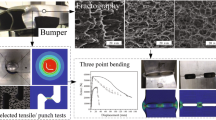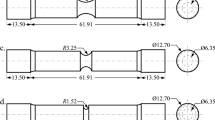Abstract
Fracture loci of a ductile sheet metal, in some stress subspaces, can be predicted by determining the fracture stress points in the same subspace. This paper deals with determining the fracture stress points for Ti–6Al–4V alloy, under biaxial tension loading, at different temperatures and strain rates. For this purpose, biaxial tension of a fracture cruciform specimen was numerically simulated, using the ABAQUS software. In order to validate the finite element simulations, biaxial tensile fracture of an AA5083 cruciform specimen was numerically and experimentally studied. The material properties of AA5083 needed as the input data for simulations, were determined by performing experimental tests. Moreover, a dependent biaxial tensile mechanism was designed, manufactured and installed on an INSTRON-1343 uniaxial testing machine, to conduct the biaxial experimental tests. The numerical predictions for the location of fracture initiation, the path of fracture evolution and the force diagram in each of the specimen arms were compared with the experimental results. A good correlation was observed which confirms the validity of the finite element simulations. Then, the simulations were repeated for Ti–6Al–4V specimen. Hill1948 criterion was used to model the anisotropic plasticity, while Johnson–Cook damage model was incorporated to predict the fracture initiation and evolution path for different temperatures and strain rates. The results showed that the biaxial fracture stress points, corresponding to different displacement ratios, are mainly accumulated in the vicinity of equi-biaxial stress state. It can be concluded that, regardless of the anisotropy model, the fracture cruciform specimen cannot reveal a wide range of biaxial tension stress points.



















Similar content being viewed by others
References
Hannon A, Tiernan P (2008) A review of planar biaxial tensile test systems for sheet metal. J Mater Process Technol 198(1):1–13
Boehler J, Demmerle S, Koss S (1994) A new direct biaxial testing machine for anisotropic materials. Exp Mech 34(1):1–9
Yu Y, Wan M, Wu X-D, Zhou X-B (2002) Design of a cruciform biaxial tensile specimen for limit strain analysis by FEM. J Mater Process Technol 123(1):67–70
Gutscher G, Wu H-C, Ngaile G, Altan T (2004) Determination of flow stress for sheet metal forming using the viscous pressure bulge (VPB) test. J Mater Process Technol 146(1):1–7
Quaak G (2008) Biaxial testing of sheet metal: an experimental-numerical analysis. Eindhoven University of Technology, Department of Mechanical Engineering, Computational and Experimental Mechanics, pp 1–33
Leotoing L, Guines D, Zidane I, Ragneau E (2013) Cruciform shape benefits for experimental and numerical evaluation of sheet metal formability. J Mater Process Technol 213(6):856–863
Abu-Farha FK (2007) Integrated approach to the superplastic forming of magnesium alloys. University of Kentucky Doctoral Dissertations. 493. https://uknowledge.uky.edu/gradschool_diss/493
Leotoing L, Guines D (2015) Investigations of the effect of strain path changes on forming limit curves using an in-plane biaxial tensile test. Int J Mech Sci 99:21–28
Deng N, Kuwabara T, Korkolis Y (2015) Cruciform specimen design and verification for constitutive identification of anisotropic sheets. Exp Mech 55(6):1005–1022
Schödel M, Zerbst U, Dalle Donne C (2006) Application of the European flaw assessment procedure SINTAP to thin wall structures subjected to biaxial and mixed mode loadings. Eng Fract Mech 73(5):626–642
Kuwabara T, Ikeda S, Kuroda K (1998) Measurement and analysis of differential work hardening in cold-rolled steel sheet under biaxial tension. J Mater Process Technol 80:517–523
Makinde A, Thibodeau L, Neale K, Lefebvre D (1992) Design of a biaxial extensometer for measuring strains in cruciform specimens. Exp Mech 32(2):132–137
Ferron G, Makinde A (1988) Design and development of a biaxial strength testing device. J Test Eval 16(3):253–256
Fraunhofer (2005) Dynamic material testing. http://www.emi.fraunhofer.de
Brieu M, Diani J, Bhatnagar N (2006) A new biaxial tension test fixture for uniaxial testing machine—a validation for hyperelastic behavior of rubber-like materials. J Test Eval 35(4):364–372
Vezer SZ, Major Z (2004) Development of an in-plane biaxial test setup for monotonic and cyclic tests of elastomers. In: Proceeding of 25th Danubia-Adria symposium on advances in experimental mechanics. Polymer Competence Center Leobben
Khan AS, Liu H (2012) Strain rate and temperature dependent fracture criteria for isotropic and anisotropic metals. Int J Plast 37:1–15
Yilmaz A (2011) The Portevin–Le Chatelier effect: a review of experimental findings. Sci Technol Adv Mater 12(6):063001
Robinson J (1994) Serrated flow in aluminium base alloys. Int Mater Rev 39(6):217–227
Li X, Guo G, Xiao J, Song N, Li D (2014) Constitutive modeling and the effects of strain-rate and temperature on the formability of Ti–6Al–4V alloy sheet. Mater Des 55:325–334
Banabic D (2010) Sheet metal forming processes: constitutive modelling and numerical simulation. Springer, Berlin
Abaqus 6.14 Documentation (2014) Analysis user’s guide, ductile damage. III: Material (Section 24.2.2)
Kut S (2010) A simple method to determine ductile fracture strain in a tensile test of plane specimen’s. Metalurgija 49(4):295–299
Khan AS, Liu H (2012) A new approach for ductile fracture prediction on Al 2024-T351 alloy. Int J Plast 35:1–12
Lemaitre J (1985) A continuous damage mechanics model for ductile fracture. J Eng Mater Technol 107(1):83–89
Abaqus 6.14 (2014) Analysis user’s guide, Johnson–Cook dynamic failure. III: Material (Section 23.2.7)
Sun J, Guo YB (2009) Material flow stress and failure in multiscale machining titanium alloy Ti–6Al–4V. Int J Adv Manuf Technol 41:651–659
Johnson GR, Cook WH (1985) Fracture characteristics of three metals subjected to various strains, strain rates, temperatures and pressures. Eng Fract Mech 21(1):31–48
Lin Y, Chen X-M (2011) A critical review of experimental results and constitutive descriptions for metals and alloys in hot working. Mater Des 32(4):1733–1759
Djavanroodi F, Janbakhsh M (2013) Formability characterization of titanium alloy sheets. In: Titanium alloys-advances in properties control. InTech
Djavanroodi F, Derogar A (2010) Experimental and numerical evaluation of forming limit diagram for Ti–6Al–4V titanium and Al6061-T6 aluminum alloys sheets. Mater Des 31(10):4866–4875
Janbakhsh M, Riahi M, Djavanroodi F (2012) Anisotropy induced biaxial stress–strain relationships in aluminum alloys. Int J Adv Des Manuf Technol 5(3):1
Polyzois I (2010) Finite element modeling of the behavior of armor materials under high strain rates and large strains, University of Manitoba, Master of Science Thesis
Kotkunde N, Deole AD, Gupta AK, Singh SK (2014) Experimental and numerical investigation of anisotropic yield criteria for warm deep drawing of Ti–6Al–4V alloy. Mater Des 63:336–344
Khan AS, Yu S (2012) Deformation induced anisotropic responses of Ti–6Al–4V alloy. Part I: experiments. Int J Plast 38:1–13
Acknowledgements
This research is in line with the project of “the Design and Manufacturing of the Ti–6Al–4V Alloy Large Scale Spherical Vessel under Relatively High External Pressure.” We would like to thank the Dean of the Faculty of Sea for their continued support of our project. Second, we would like to thank the experts at the Iranian Aviation Industry, HESA, for their continuous support in experimental and laboratory-based examinations. A third, special thanks go to R. Mousavi and B. Azizian for their cooperation in the making of the biaxial tensile mechanism.
Author information
Authors and Affiliations
Corresponding author
Additional information
Technical Editor: Paulo de Tarso Rocha de Mendonça, Ph.D.
Rights and permissions
About this article
Cite this article
Farhadzadeh, F., Salmani-Tehrani, M. & Tajdari, M. Determining biaxial tensile stresses by fracture cruciform specimen at different temperatures and strain rates for Ti–6Al–4V alloy. J Braz. Soc. Mech. Sci. Eng. 40, 532 (2018). https://doi.org/10.1007/s40430-018-1455-3
Received:
Accepted:
Published:
DOI: https://doi.org/10.1007/s40430-018-1455-3




